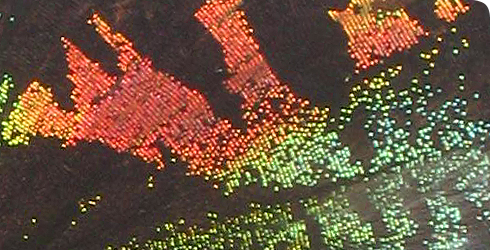Taxonomy
Morphology
Adult wing, scales and sound production
- pattern consists of metallic green blue and orange stripes on a velvet black background (no orange underneath)
- pattern usually asymmetric (see hind wing)
- scale ultrastructure
- ribbon-like scales that make up the metallic colour patterns
- modified into a highly specialised stridulatory organ of the male foreleg (Lees. 1992)
Scale ultrastructure in Urania and the related genus Chrysiridia has long been a textbook example of interference colours and the optical physics of the colours, studied in related species (Prum et al. 2006).
Eggs
Eggs were
- globular
- slightly flattened at poles
- with numerous vertical ridges
- yellowish-white
Described but not illustrated by Gosse (1851)
Larva - late instar
- grew to 44mm long and 6.4mm wide
- had a fulvous-red head
- had a full complement of white prolegs
- its thorax and abdomen were black marked with
- a longitudinal band straddling the blue-black midline, consisting of two lateral parallel and somewhat interrupted white lines, which are criss-crossed irregularly by intersegmental white crosslines, giving an effect as if painted with square white Hebrew characters.
- interrupted slender lateral white lines running along the line of the spiracles.
- black ventral surface, with a cream band on either side.
- a whorl of apparently deciduous long slender fusiform hairs which were black at base and white distally, more numerous in younger [instars].
Described but not illustrated by Gosse (1881)
Pupa
The pupa was
- smooth and shiny
- red-brown
- about 21.6mm long and 0.69cm wide
- with a whorl of blunt points on each abdominal segment.
- with black nervules visible on wing cases
- attached firmly to cremaster by a strong silk thread
- as typically for Urania probably in an open weave cocoon (Lees and Smith, 1991).
Described but not illustrated by Gosse (1881)
-
Diagnostic description
Find out more about the specific features that distinguish Urania sloanus from the other members of the genus Urania.
-
Lookalikes and evolution
Find out more about how the similarities between Urania sloanus and the genus Chrysiridia from Madagascar and Tanzania.
